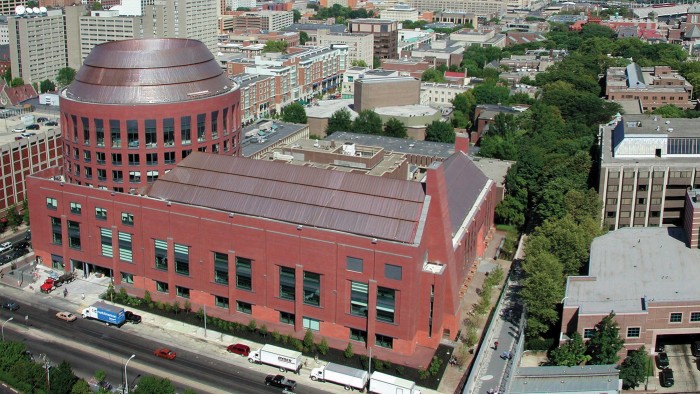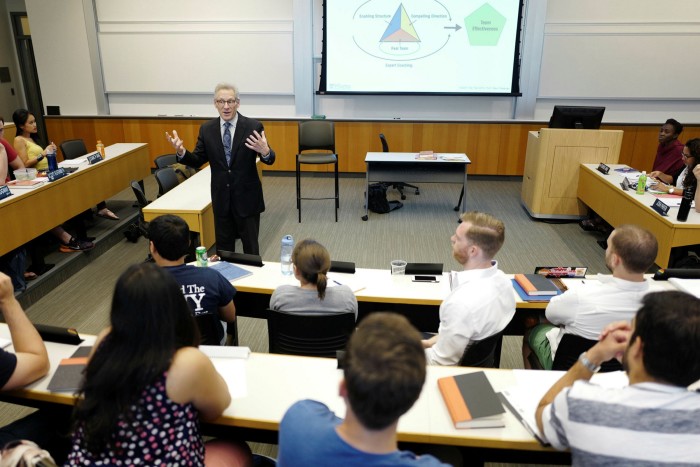FT Global MBA Ranking 2022: US business schools dominate

Roula Khalaf, Editor of the FT, selects her favourite stories in this weekly newsletter.
High salaries for American MBA graduates helped US business schools to the top places in the FT’s 2022 ranking after a year that brought strong demand for the degree amid the disruption of the pandemic.
Wharton and Columbia came first and second, respectively, ahead of Harvard, Northwestern: Kellogg, Stanford, Chicago: Booth, Yale, MIT, NYU: Stern and Berkeley: Haas — which were all among 16 schools in the top tier of the 100 ranked institutions.
Insead, in France and Singapore, came third. Others in the top tier include London Business School, Iese in Barcelona, HEC Paris, SDA Bocconi in Milan and China Europe International Business School (Ceibs) in Shanghai.
Three years after graduating, alumni of The Wharton School of the University of Pennsylvania reported the highest overall average annual income in 2021, at $238,000, after removing the salaries of those going into lower-paid areas of work, such as the public sector. The average salary overall for alumni of the 100 schools ranked this year was $161,000, once adjusted for purchasing power parity around the world.
FT Global MBA Ranking 2022 — the top 100

Find out which schools are in our ranking of MBA degrees. Learn how the table was compiled and read the rest of our coverage at www.ft.com/mba.
While many business schools were squeezed by a fall in non-diploma executive education during the pandemic, MBAs held up well. “We beat our expectations on intake,” says Francois Ortalo-Magné, dean of London Business School. “Demand has been very strong for our full-time programmes.”
Among the 81 schools ranked in each of the past three years, the total MBA intake rose to 14,566 in 2021, up from 14,168 in 2019 and signalling a recovery after a dip to 13,534 in 2020. Average alumni salaries rose over the period (2019-21) from $130,875 to $141,949, without adjusting for inflation and exchange rates.
A survey last year by the Graduate Management Admission Council showed that 37 per cent of recruiters expected MBA hiring to increase over the next five years, compared with 30 per cent of those who responded in 2020. A separate survey showed that a majority of FT-ranked business schools reported a rise in international students, notably from India, offsetting a decline in domestic candidates.
The FT rankings are based on data provided by participating schools and alumni, with significant weightings given to salary and salary increase three years after completion, as well as factors including academic research output, and student and faculty diversity measured by gender mix and citizenship.
Andrew Crisp, head of the educational consultancy CarringtonCrisp, said that business schools would need to continue evolving as newer digital forms of business training expand. “International, entrepreneurship, technology, sustainability are the buzz words,” he says. “It’s absolutely vital that the MBA adapts to where the world is. If it doesn’t, it will be in a very difficult position.”

Half of the 100 FT-ranked schools — which must be accredited by the Association to Advance Collegiate Schools of Business or Equis, the two leading international agencies — are based in the US, the home of the MBA and where the qualification remains essential for many seeking management roles or to progress within them.
Nine ranked schools are in the UK, with smaller numbers in other European countries, Canada and Australia. But, in a sign of the geographical expansion of business education, there are six ranked in China, three in Hong Kong, four in India and one in each of Mexico and South Korea.
Harvard scored highest for research output, measured by staff publications in journals on the FT50 list, weighted by faculty size. It was followed by Wharton and Chicago: Booth.
In a sign of a growing focus on sustainability, about a third of the 100 ranked schools reported that they had completed a carbon emissions audit on their campus and a quarter included the most comprehensive Scope 3 emissions, covering indirect contributors such as travel.
As pressure increases on governments to limit global warming to less than 2C above pre-industrial levels, 19 of the schools said they aimed to achieve net zero carbon emissions within 20 years. Iese scored top for the integration of environmental, social and governance factors, followed by Ohio State University: Fisher and France’s Edhec.
The University of Florida: Warrington ranked top for value for money — calculated by current income after accounting for tuition costs and earnings forgone during study — followed by Lancaster University Management School in the UK and Brigham Young University: Marriott in the US.
None of the ranked schools reported gender parity among faculty, although 49 per cent at IE Business School in Spain were women. Six of the nine schools where women comprised more than half of the students were in Asia, led by Tongji University School of Economics and Management and Fudan University School of Management in China.
The biggest salary increases reported by students three years after completion compared with earnings before starting their MBAs were at the Indian School of Business, Fudan and Mexico’s Ipade Business School.
Comments